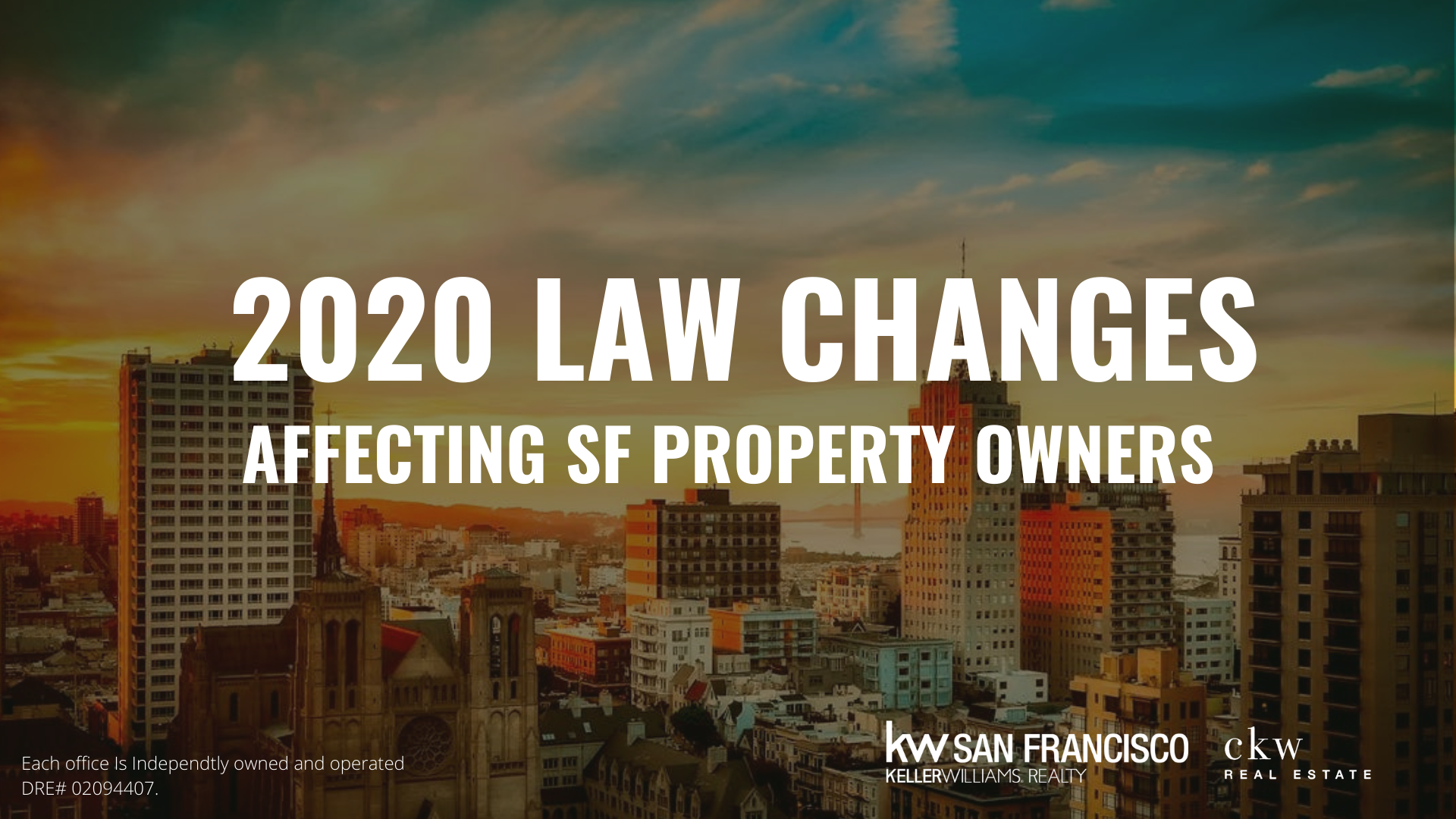2020 Law Changes Affecting SF Property Owners
5 Changed Laws That Affect San Francisco Property Owners
Disclaimer: I am not a lawyer and should not be relied upon for legal advice. Please contact a real estate attorney to verify or discuss any of the following law changes further. Nothing in this article is to be received as legal advice.
Since 2020, the San Francisco board of supervisors have changed 2 members and many more real estate laws. With Mayor London Breed retaining less support than imagined, the board of supervisors has turned more progressive, focusing on changing laws to meet the increased housing demand and serve existing tenants. First, the San Francisco Board of Supervisors passed the Intermediate Length Occupancy Law (ILO) and the Community Opportunity to Purchase Act (COPA) as part of their active pro-tenant initiative. To address the unmet housing demand, the board relaxed Accessory Dwelling Unit (ADU) regulations, making it easier to build small units under 1,000 square feet on existing properties. Finally, the board amended the Planning Code procedure to legalize illegal units. What does all this mean for property owners?
1. Relaxed ADU Regulation Means More Real Estate
California only has so much space, but rental demand seems infinite. How can the state find apartments for everyone? Some real estate experts point to accessory dwelling units (ADUs), which are small units under 1,000 square feet that can be added to existing properties, sometimes manufactured or even built from shipping containers. ADUs offer much-needed space and can be built in a fraction of the time and cost of a standard apartment building. In an effort to meet California’s rental demand, 2020 state laws greenlit more ADUs per lot than ever before. While California cities can tweak their ADU laws, they can only make laws more inclusive for ADUs, not restrictive. This means more ADUs for everyone.
To build more homes faster, new laws have created State-Mandated ADU’s (No Waiver ADU’s) that are exempt from subjective design review. These ADUs have a shortened approval period of just 60 days and are exempt from local developer impact fees if smaller than 750 square feet. ADUs are also exempt if they’re set on a lot of 3 or fewer units.
State law also encourages property owners to develop more detached ADUs. In 2021, 2 more ADU units can be added in the rear yard of a lot that already contains 2+ units. No rear yard variance is required as long as the units are 1,000 or fewer square feet and are set back 4+ feet from property lines. Technically, there are no regulations for the distance between new structures and existing structures. Property owners face no limit to the number of ADUs they can build from an existing structure of 2+ dwelling units, as long as the new number of ADU’s created doesn’t exceed 25% of the number of existing legal dwelling units.
Finally, state law has created a new class of ADU: the Junior ADU (JADU), which is a 500 square feet or smaller unit for single-family residents. This means the owners must occupy either the property’s primary unit or the JADU. However, JADUs are the only units that require owners to reside in their ADU. All other California laws that require owners to reside in the ADU will be discontinued until at least 2025. However, ADUs are still a key part of their property and cannot be sold separately from other units. While ADUs may be subject to local rent control laws, on the whole, the rise of ADUs should allow for a freer real estate market with more space and fewer legal hiccups.
2. Limited Intermediate Length Occupancy Housing (ILO Housing)
Dwellings that are rented for periods longer than 30 days but shorter than 1 year are known as “Intermediate Length Occupancy” (ILO). Since ILO dwellings can charge high rents and limit permanent housing for residents, the board considered banning ILO dwellings altogether. They settled on a major restriction. In June 2020, the planning code was amended to limit the number of ILO homes to just 1,000. Now, owners must apply for permission to rent their ILO dwellings. Permission will only be granted to the first 1,000 units, making this a first-come, first-serve system. However, between 2,000 and 2,700 units were being used as ILO housing units before the amendment, meaning many owners won’t keep their ILOs. Location can make approval even more competitive. Over 66% of the 1000 ILO units are required to be in the “downtown core” of the city and no more than 33% of ILO units can be in low-income communities.
San Francisco set strict standards for buildings to even qualify as an ILO. 5 types of buildings that cannot qualify as ILOs include 1-3 unit buildings, buildings subject to Notices of Violation, rent-controlled units, units designated “below market rate”, and of course buildings built after June 2020, the date this law went into effect.
For buildings with 4-9 units, planning staff alone can approve ILO units. For buildings with 10+ units, the Planning Commission must approve ILO units personally. However, the Commission will not approve an ILO if more than 20% of the units in the building of 10+ units are already classified as ILOs. For buildings with 4-9 units, the Commission won’t approve ILO if more than 25% of the units are already ILOs.
No grandfather provisions apply, meaning units that have been rented for more than a month but less than a year must register. To legalize existing rentals or build new ILO units, property owners first file an alteration or building permit with the Building Department. They then move into the Planning Department review process to get a final answer.
3. Nonprofits Make the First Move with Community Opportunity to Purchase Act (COPA)
The Community Opportunity to Purchase Act (COPA) aims to prevent tenant displacement and encourage affordable housing by putting homes in the hands of qualified nonprofits. When a residential property of 3+ units is for sale, COPA now gives nonprofits the right to make the first offer. Nonprofits also bid first on vacant lots that can be developed into 3+ unit buildings. Prudence now requires sellers to comply with certain COPA Notice of Sale rules before listing and marketing their properties for sale so nonprofits can make the first move. This change also means real estate agent listing agreements may now address the possibility of COPA sales.
COPA gives nonprofits 5 days to notify the seller if they are interested in making an offer to buy the property. If the nonprofit expresses interest, the seller must provide further disclosures to the nonprofit, including the contact info for the tenants. This triggers an additional 25-day period during which the nonprofit may offer to purchase the property. If no nonprofit is interested in making an offer within the initial 5-day period, the seller may proceed normally and solicit 3rd party offers for purchase, without any Rights of First Refusal.
Even with COPA, sellers are not required to accept an offer. Sellers can refuse any nonprofit they want. The only exception is if a nonprofit offers to buy and is rejected by the seller, but then acquires a Right of First Refusal to purchase the property by matching the terms and conditions of a 3rd party sale. In this 3rd-party scenario, the seller must provide notice to any nonprofit whose initial offer was declined, setting the terms and conditions the seller has received from any 3rd party purchase offer that the seller plans to accept.
Changes to the terms and conditions of a 3rd party sale may be considered a new offer. In this case, the Right of Refusal process restarts, and the seller must present again to every nonprofit that declined the original offer. COPA also allows for “conditional” 3rd party sales agreements. If a seller wants to accept an offer from a 3rd party or if the seller makes an offer a 3rd party wishes to accept, the deal may be accepted so long as no qualified nonprofits exercise their Right of First Refusal. Barring complex 3rd-party sale scenarios, however, COPA primarily means nonprofits get a head start when bidding for 3+ unit properties, which may be factored into your real estate agreement when working with an agent.
4. New procedure to legalize illegal units to fight housing loss
San Francisco has been struggling with housing loss for years. In a booming market like the Bay Area, housing loss makes housing less financially accessible and damages neighborhoods. To fight housing loss, the board passed new limits on removing illegal dwelling units. There will be fewer exceptions to the requirement that the Planning Commission personally approves the removal of illegal units. However, legalizing can prove costly and may not always be worth pursuing. How will the Commission decide if a unit being removed is worth legalizing?
First, the Commission will compare the cost to legalize the unit versus the added value legalizing the unit would give the property. The unit can be legalized if the increase in the property’s value is at least equal to the cost of legalization. Second, the Commission will compare the cost to legalize the unit under local codes to the average cost to legalize a unit based on the Planning Department’s Master List of Additional Dwelling Units Approved and their costs. However, if the cost of legalizing poses a financial hardship to the property owner, the Commission may be able to assist with city funds. This new assessment procedure aims to eliminate housing loss while making the legalization process more efficient and personal.
5. Fewer Rental Restrictions For Condos
New California laws aim to increase affordable housing by limiting how homeowners associations (HOAs) can restrict rental CIDs (Common-interest Developments). HOAs must amend their governing documents to conform to these new laws.
Starting January 2021, a new civil code section requires the governing documents (project declarations, CC&Rs, HOA bylaws, HOA rules, etc) of a CID to not prohibit the rental of a unit.
First, minimum lease terms (even for HOAs) cannot be greater than 30 days. This means regular lease terms of 6 months or 1 year are no longer valid. Next, the maximum number of rentals permitted in a CID can’t be less than 25% of the units in the project. However, accessory dwelling units (ADUs) rentals are exempt from the 25% cap. All HOAs are required to amend their CC&Rs and other documents to meet these requirements by December 31, 2021.
While this may create more available and affordable housing, it may also create a hassle for existing HOAs and condo owners, especially those with 6 months to 1-year leases. HOAs should review their governing documents to ensure they’re in compliance with the new law.
LINKS TO OTHER BLOG ARTICLES
QUICK GUIDE TO BUYING A HOUSE IN SAN FRANCISCO
THINGS YOU CAN DO WHILE QUARANTINED AT HOME
HOW TO BUY A HOME DURING COVID-19
GOVERNOR GAVIN NEWSOM’S EXECUTIVE ORDER EFFECTS ON REAL ESTATE
TO BUY OR NOT TO BUY IN SAN FRANCISCO DURING SHELTER-IN-PLACE
WHAT THE CARES ACT MEANS FOR YOU (CORONAVIRUS AID, RELIEF AND ECONOMIC SECURITY ACT)
CONSTRUCTION UPDATES FOR SHELTER-IN-PLACE
CONFIRMING WITH THE IRS WHERE TO SEND YOUR STIMULUS $$$
SAN FRANCISCO: IS NOW A GOOD TIME TO SELL A HOUSE?
HOW SAN FRANCISCO REAL ESTATE GOT SO EXPENSIVE AND WHY SF REAL ESTATE VALUES HOLD
HOW TO CHOOSE A REALTOR TO SELL YOUR INVESTMENT PROPERTY IN SAN FRANCISCO: 5 ESSENTIAL TIPS
PROP 19 PROPERTY TAX CHANGES & ACTIONS TO TAKE
COMMERCIAL REAL ESTATE PROS & CONS
ABOUT CRYSTLE
As the CEO of a San Francisco-founded, global tech startup, Crystle understands from experience what it takes to succeed. Her real estate experience spans from successfully managing multiple properties over the last 10+ years including residential, commercial, and mixed-use, as well as her time spent actively investing in flipping properties, tax liens, tax deeds, and other property types. As a native-born and raised in San Francisco, you can trust that you’re in the good hands of a local who can help you navigate the micro-neighborhoods of San Francisco. Crystle invests in relationships and you can count on her to walk with you through the process of buying or selling your property.
You might ask yourself, “What does a tech startup have to do with real estate?”
Good question! Everything about Crystle exudes intention. Her ultimate goal is to grow her tech company so that she can utilize its philanthropic arm to fund micro-housing for the homeless in partnership with key, long-standing, and successful social services organizations in San Francisco. Real Estate gives her the ability to network and learn about developing land to purchase in the future to develop micro-housing. Her time serving on boards for these nonprofits gives her the knowledge of what these organizations really need to be able to get more people off the streets for good.
HER CURRENT FOCUS WITH REAL ESTATE CLIENTS IS TO WORK AND PARTNER WITH CHURCHES, NONPROFITS, AND AFFORDABLE HOUSING DEVELOPERS.
The same cornerstones that drive success in her tech company are the same cornerstones that make her the best real estate agent to work with: honesty, transparency, integrity, and a relationship-focused mindset toward life.
Crystle was born and raised in San Francisco’s Inner Richmond district and continues to choose to establish her future life in San Francisco as well. She is a woman of her word. She not only financially supports several not-for-profits, but also regularly serves in her community helping the homeless, youth, and those in poverty.
In her spare time, she is an active and current member of the Board of Directors of Lutheran Social Services of Northern California, the APA Heritage Foundation Committee of San Francisco, and volunteer with Mobilize Love. She has previously and faithfully served on the Board of Directors for Zion Lutheran Church and School of San Francisco, the Board of Directors for Designing a Difference, the Board of Directors for APAPA San Francisco, a member of the Friends of Smuin Ballet, and as a Co-Chair for the Princess Project.






